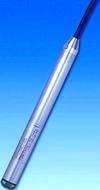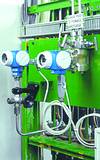
Pressure is one of the most frequently measured variables in process engineering (Figure 1). Apart from monitoring container and pipe pressure to ensure safe operation, pressure is also used to determine other process parameters, including measuring levels in open and pressurised tanks and for flow measurement.

In the past, differential pressure sensors have predominantly been used for level measurement, since they can measure small pressures with great accuracy. However, today level measurement using pure pressure sensors, that can commonly measure ranges of 0 to 5 mbar, is becoming increasingly important. In addition, the introduction of ceramic measuring elements has reduced costs for users, while extending not only the range of pressure measurement applications, but also the range and type of pressure measurement devices.
Ambient requirements, such as high temperature combined with vacuum and extreme resistance to corrosion or condensation, coupled with the increasing need to meet specific industry sector requirements - for example the FDA conformity - makes it impossible to have one instrument that covers all sectors. Three examples from different areas of the chemical industry provide an overview of the wide range of applications of pressure transmitters, highlighting the benefits of device specialisation in terms of cost-savings, and also in relation to safety and the availability of production-specific processes.
Electrical differential pressure measurement at columns
The pressure in the column is an important control variable when operating rectification columns. This is determined by differential pressure measurement between the head and the base, performed by differential pressure transmitters that have proven their reliability over time.
In practice, however, this type of measurement can be complicated by peripheral factors. For one, columns are often high which means that just laying the pressure piping and capillaries is time consuming and difficult. In addition, when using capillary pressure transmitters, exact measurements are only possible if the capillaries are maintained at a constant temperature.
Vacuum rectification is used to reduce the boiling point, especially when rectifying mixtures that are sensitive to temperature. However, vacuum is problematic near the absolute zero point, especially for oil-filled systems, which tend to form bubbles that increase the zero point drift on the transmitter.
These complications to accurate measurement can be avoided if the differential pressure is determined by electrical differential pressure measurement. In contrast to a differential pressure transmitter, the pressure in the head and the base is measured separately at both points by means of a pure pressure transmitter, such as the Cerabar S. The difference between the two measured values is then calculated in a separate switching unit or in the plant controls.
Electrical differential pressure measurement has a number of advantages: Installation is considerably easier, as now only electrical lines need to be laid, and the height of the column is not a hindrance; the pressure piping can no longer freeze or get clogged-up; measuring errors caused by capillaries of different temperature (irradiation) can be ruled out; absolute vacuum-proof, oil-free ceramic cells can be used, which provide for head and base pressure variables in addition to the differential pressure over the column. All of these factors provide for better control and monitoring purposes in the plant.
Electrical measurement is used extensively in fermentation processes (Figure 2). There is, however, one prime limitation to this measurement technique, this being the accumulation of small differential pressure errors when monitoring high static pressures. Here, electrical measurement becomes inaccurate, especially if digital sensors are not being used. But, under the right conditions, electrical differential pressure measurement is an attractive option.

Expert pressure measurement in sterile sectors
During pharmaceutical processes all steps and risks on the path to production are recorded in a validation master plan, including machines, materials and measuring technology. Pressure and hydrostatic level are two vital process parameters that need to be monitored.
The Cerabar M pressure sensor (Figure 3), which can be used without any restrictions during CIP and SIP, is available with either a piezo-restrictive sensor with metallic measuring membrane, or a capacitive ceramic measuring cell, which works without filling oil. Long-term stability and overload-proof measuring with a high level of accuracy is common to both pressure measuring methods.

Only materials which the FDA categorises as non-hazardous are in contact with the process, including the high-purity Ceraphire ceramic (99,9% A2O3) and the seal (EPDM, NBR). In addition, all the exterior metallic parts of the Cerabar M, including the housing, are made from CrNi-steel AISI 316 L, which is standard in pharmaceutical plants.
The construction of this housing was tailor-made to fulfil the requirements for hygienic applications. The corner and edge-free design, together with ingress protection to IP68, and hygienic connections, also provide the level of safety required for external cleaning. A wide range of flush-mounted process connections, with a superior finish, is available for the Cerabar M for use in pharmaceutical applications. The pressure sensor was awarded the 3-A certificate for hygienic construction and also received a report from the EHEDG on its ability to be easily cleaned.
Level measurement in water treatment
Pressure measuring instruments also have a wide range of applications in the area of water treatment, such as hydrostatic pressure measurement, which is often used for level measurement. Theoretically, this type of level measurement is nothing more than a relative pressure measurement of the liquid column to be measured in relation to the ambient air pressure.
Here, ambient pressure compensation is essential for exact measurement results since, depending on the altitude and weather conditions, air pressure can fluctuate by up to 5 kPa - which corresponds to error of 500 mm. Level measurement with hydrostatic pressure sensors is advantageous as the principle is not influenced by foam formation or other objects floating on the surface. However, a prerequisite for long-term stable measurement is that the sensors are not corroded or destroyed by the fluid.
The Waterpilot level probes (Figure 4) are equipped with high-precision ceramic sensors that are stable and robust. The probes can be used in a wide variety of difficult applications, such as in the sand collector of a sewerage treatment plant - with highly abrasive sand eddies.

A specially-developed small ceramic has enabled probes with an external diameter of just 22 mm to be produced, ideal for use in very narrow sounding pipes. An integrated temperature sensor also allows temperature to be measured online, simultaneously with level. The probes can successfully resist the effects of weather changes when filter systems are included in the pressure compensation tube and their integrated over-voltage protection. The materials used in the Waterpilot are also suitable for use in drinking water, which is of particular importance when purifying river- and well-water for drinking.
The Waterpilot level probes have a 4 to 20 mA output signal, which can be further processed in an SPS or a custom-made switching unit for the measuring task. In addition to a wide range of accessories for mechanical integration, intelligent feed and signal processing units to provide tailor-made solutions. In this way, using the RMA 422 process transmitter, for example, level and temperature signals can be evaluated and downstream consumers can be kept informed. The probe only requires as supply voltage.
To prolong the service life of pumps and reduce maintenance costs, several can be controlled alternately. It is also possible to detect level trends for early reaction using the RMA 422 process transmitter. This solution package clearly shows the trend away from 'simple' sensors, towards intelligent compact instruments with the corresponding processing unit, which provide for tailor-made measuring point solutions.
For more information contact Grant Joyce, Endress + Hauser, 011 262 8000, [email protected], www.za.endress.com
| Tel: | +27 11 262 8000 |
| Email: | [email protected] |
| www: | www.endress.com |
| Articles: | More information and articles about Endress+Hauser South Africa |

© Technews Publishing (Pty) Ltd | All Rights Reserved